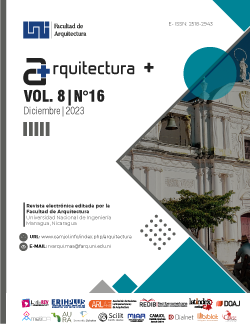Semiotic Language in Architecture: Between signs and meanings
DOI:
https://doi.org/10.5377/arquitectura.v8i16.17430Keywords:
Architecture, Semiotics, Semiology, Language, PedagogyAbstract
Giving a methodological sense to the teaching-learning processes in architecture is essential for the training of both students and teachers. Therefore, within the framework of the research titled "The Nine Languages of Architecture," a characterization is provided for various languages that constitute architecture. This document integrates semiotic language not as a capricious or vain act; on the contrary, it seeks to recognize semiotics beyond a concept and the simplicity of its meaning (which is by no means simple). This recognition infuses a profound dogma of its entire logic, use, and development within the education of future architects, particularly when aiming for its integration into everyday professional life. Additionally, when exploring authors and thinkers on semiotics in architecture, an immersion is evident among professionals from other disciplines, presenting extensive knowledge. This impact influences researchers involved in this orthodox theme in the foundation of architecture. The methodology of this essay stems from a central investigation titled "The Nine Languages of Architecture," defining a qualitative-descriptive approach that involves collecting and analyzing non-numerical data to explore meanings and interpretations. Although this essay does not conclusively define the use of the term semiotics or semiology, it provides guidelines regarding its usage and general applicability within the architectural domain.
Downloads
References
Báez, F & González, K. (2021). ¿Arquitectura, parte integral de las Ciencias sociales?, Nexo Revista Científica, 34 (5), 75-82. DOI: 10.5377/nexo. v34i05.13111
Becerra, F. (2017). La noción de lenguaje en Jacques Lacan: Del Signo Lingüístico en Saussure al Algoritmo Saussureano en Lacan. Revista Filosofía UIS. 16 (1), 180-192, http://dx.doi.org/10.18273/revfil.v16n1-2017009
Bertalanffy, L. (1973). General System Theory. Harmondsworth: Penguin.
Dorfles, G. (1966). Símbolo, comunicación y consumo. Barcelona: Lumen S.A.
Eco, U. (1999). La Estructura Ausente. España: Lumen S.A.
Francioni, M. (1983). Psicoanálisis, Lingüística y Epistemología en Jacques Lacan. Argentina: Gedisa S.A.
Gasca, J. y Zaragozá, R. (2016). Designpedia. 80 herramientas para construir tus ideas. Madrid, España: Colección LEO.
Hall, E (1959). The Silent Language. Nueva York. Dobleday.
Hernández, H. (2022). Arquitectura y Escultura. El Oficio del Arquitecto, pp 87 – 95. Bogotá D.C. ACFA.
Koenig, G. (1964). Analisi del linguaggio architettonico. Florencia: Fiorentina.
Le Corbusier. (1923). Vers une architecture [hacia una arquitectura]. G. Crés & Cie
Leech, G. (1981). Semántica. (2a ed.). Madrid, España: Alianza.
Luque, J. (1996). La Ciudad de la Arquitectura una Relectura de Aldo Rossi. España: Oikos-Tau.
Menéndez, P. (2016). Ambiente humano para ciudades felices. Colombia: ECOE ediciones.
Morris, C. (1985). Fundamentos de la teoría de los signos. Buenos Aires, Argentina: Paidós.
Ortiz, J. (s.f). El carácter único del edificio se afianza en la memoria colectiva, que simboliza los esfuerzos de las víctimas del conflicto y de quienes pensaron en la paz. https://museodememoria.gov.co/diseno-del-edificio/un-museo-en-el-corazon-de-la-ciudad/
Park, R. (1974). The City: Suggestions for the investigation of human behavior in the urban environment. Chicago: University of Chicago
Saussure, F. (1945). Curso de Lingüística General. Buenos Aires: Losada.
Sennett, R. (1997). Carne y Piedra. Madrid: Cultura Libre.
Wirth, L. (1938). Urbanism as a way of life. American Journal of Sociology, 44, 1-24.
Downloads
Published
How to Cite
Issue
Section
License
Copyright (c) 2023 Universidad Nacional de Ingeniería

This work is licensed under a Creative Commons Attribution-NonCommercial-NoDerivatives 4.0 International License.




















